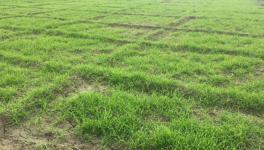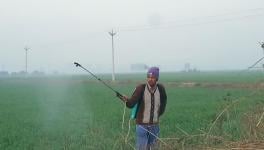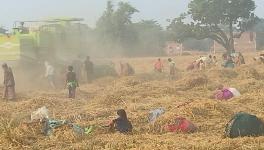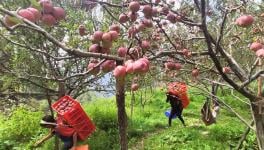Leaf Miner Pest Control a Double-edged Sword for Apple Growers of Shopian
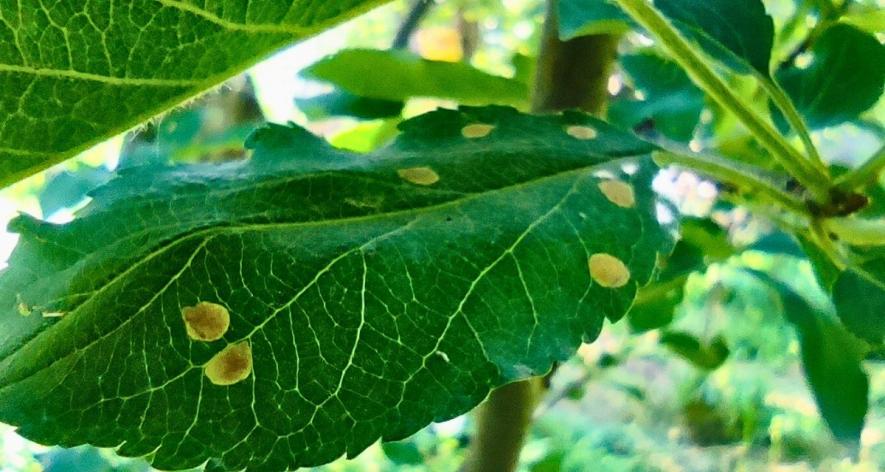
Infected leaf of Apple Tree
Shopian, Kashmir: Apple orchard owners of Shopian district in Kashmir division have been dealing with the after-effects of Apple Leaf Blotch Miner (ALBM) for the last two years. The disease has been a major blot on the income generated by apple growers here.
Take the case of Shabir Ahmad Dar (45), who is forced to spend more on insecticides now. "The ALBM has had a direct impact on the quantity and quality of apples produced in my 16 kanals of land," Shabir from Durapora village in Shopian district told 101Reporters.
"Earlier, I invested around Rs 2 lakh annually on chemical sprays to control pests and diseases in my orchard. I am forced to spend another Rs 30,000 now, as only multiple spraying of specific insecticides can act on ALBM," he detailed.
Riyaz Ahmad Naik (50), from the same village, faces similar challenges. He used to spend Rs 1.90 lakh on chemical sprays, which has now increased to 2 lakh.
"I apply three sprays a month — two involving pesticides and another insecticide. The frequency of sprays is adjusted based on weather conditions, especially when there is a threat of bad weather or rainfall. Missing a spray during critical stages can have an adverse effect on the orchards, including the spread of diseases such as Apple scab, Alternaria blotch and the deadly ALBM," he detailed.
Aaqib Rashid Dar (28) from Chitragam said he was applying four different insecticides to combat ALBM in his 16-kanal plot. Before ALBM, he was spending Rs 1 lakh on pesticides and insecticides. Now, he spends Rs 30,000 on insecticides alone.
"The Horticulture Department gave us assurances that we can effectively manage and eliminate the pest by following their recommended spray schedule. However, the current fruit harvest season is far from ideal. Our orchards are heavily infested with the pest," Dar said.
What is ALBM?
The ALBM is caused by leaf miners, which belong to a family of small flies. The leaf miner pest undergoes four distinct life stages: egg, larva, pupa and adult, thus completing its lifecycle in 25 to 30 days.
The tiny, oval-shaped translucent eggs measuring just 0.24 mm in size are typically found on the underside (abaxial surface) of the leaves. Once these eggs hatch, the larvae begin to feed on the leaf's mesophyll tissues, resulting in the formation of distinctive mines or blotches.
This feeding process can lead to necrosis, ultimately impacting the photosynthesis of the affected leaves. In addition, infestation may cause premature leaf loss, further reducing the crop's photosynthetic rate, which can have a negative effect on the overall yield.
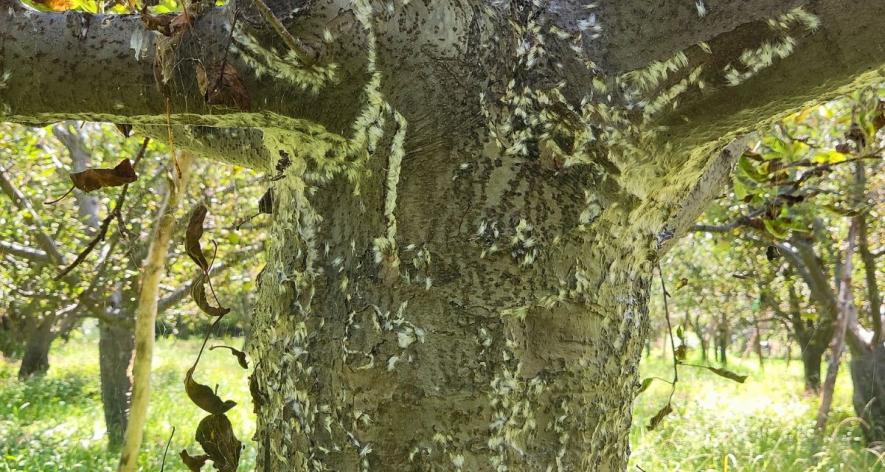
Trunks of the Apple Tree covered by Leaf Miner Pest. Photo: Aaqib Naik
The trees affected by ALBM produce small apples, and they are not as shiny as the fruit normally is. The pest has affected apple trees, irrespective of their variety. Notably, ALBM infestations tend to be more severe during the summer months.
"The presence of leaf miner traces was initially identified in the autumn of 2020 in the Kashmir Valley. However, it was only in 2021 that the pest infestation was fully understood and officially reported, particularly in the Zainapora area of Shopian district," Dr Malik Mukhtar, Entomologist, Sher-e-Kashmir University of Agricultural Sciences and Technology-Kashmir (SKUAST-K), told 101Reporters.
When the larvae damage the chlorophyll-containing cells in the leaf, the plant's capacity to produce energy from sunlight is compromised.
"Severe infestations can result in defoliation, where the entire leaf is covered with blotches or tunnels," Mukhtar added.
A pest alert report from ICAR-Indian Institute of Horticultural Research, Bengaluru, said the extent of damage due to ALBM in South Kashmir could vary widely, with leaf defoliation ranging from 13% to a staggering 100% in some cases. The estimated reduction in apple production due to ALBM is projected to be between 20% and 50%, depending on the level of defoliation observed in the fields.
Between July 31 and August 3, a team of scientists from ICAR-National Bureau of Agricultural Insect Resources and SKUAST-K held a survey on a combined cultivated area of 74,548 hectares affected by ALBM in Shopian, Anantnag, Pulwama and Anantnag districts.
As prescribed by the Horticulture Department, insecticides containing Thiamethoxam, Lambda-cyhalothrin and Imidacloprid are widely adopted against the disease. However, apple orchard farmers felt that reliance on broad-spectrum insecticides has negatively affected the fruit quality and their health.
Mohammad Shafi (38) of Durapora said the newly introduced insecticides have not been as effective as claimed. They had increased input costs and harmed the quality and size of the fruit.
"Prior to ALBM, we used to spray seven to eight fungicides and one insecticide. Now we need 13 fungicides and four insecticides," says Mir Mohammad Aasif (30) of Safanagri in Shopian district, highlighting the seriousness of the situation.
"The added expenses strain our budgets and affect our profitability," said Tariq Ahmad Sheikh, who owns 20 kanals of apple orchards at Hom Shali Bugh in Kulgam district. He claimed that over 70% of the orchards in his village have been affected.
Health, Environmental impacts
A research paper presented at the Fourth International Conference on Multidisciplinary Research at Osmania University Campus, Hyderabad, noted that farmers in the Shopian district used insecticides frequently, with 58% of respondents indicating their use. Following closely behind were fungicides (22%), herbicides (10%), rodenticides (5%), nematicides (3%) and molluscicides (2%). Regarding storage of pesticides, the majority of the respondents reported using storerooms as their primary storage location (50%), followed by cowsheds (26%).
In addition, 26.4% of farmers said they felt headaches during pesticide spraying. This was followed by nausea/vomiting (22.4%), burning/itching eyes (9.8%), fatigue (7%), cough (5.2%), running/burning nose (4.6%), muscle cramps (3%), diarrhoea/stomach pain (3.6%) and salivation (1.6%). Strangely, 16.4% of farmers reported no symptoms.
Regarding the protective measures taken during pesticide application, 27% covered their nose and mouth, 25.2% washed their hands after spraying, 6.2% covered their entire body, and the majority, 37.4%, did not use any protective measures. When asked about the recommended course of action in case someone fell ill after pesticide exposure, 72% of farmers expressed a preference for consulting a doctor.
Sharing his experience, Abid Hassan Beigh from Kulgam's Banimullah village told 101Reporters that he felt discomfort for nearly 24 hours post-spraying.
"After spraying the insecticide containing Lambda-cyhalothrin and Thiamethoxam, I felt burning and itching in my eyes and a burning sensation on the skin exposed to the insecticide. I felt relief after applying a cream," Beigh said.
Mohammad Ishaq Wagay from Awaneera in Shopian district said he experienced persistent itching and a burning sensation on his skin for approximately two days. Despite taking the medicines prescribed by the doctor, he felt relief only after a few days.
A report by the United States Environmental Protection Agency regarding the impacts of common insecticides on the environment has highlighted the potential ecological effects of three types of insecticide: Organophosphates, Pyrethroids (Cypermethrin, Lambda, Cyhalothrin), and Carbamates. These effects primarily involve mortality or developmental impacts on aquatic insects, the high toxicity of Pyrethroids to fish, and the occurrence of catastrophic and mass drift of aquatic insects.
Dr Suhaib A Bandh, Assistant Professor in Environmental Science at the Government Degree College in DH Pora, Kulgam, emphasised that research has shown that virtually no insecticide exclusively targets the intended organisms; instead, they have broad-ranging effects on various organisms, including aquatic, terrestrial, and even human health.
Sami Ullah Bhat, another assistant professor on the same subject at the University of Kashmir, Hazratbal, discussed the concerning issue of persistent pesticides and insecticides in the food chain and food web. "These chemicals have a tendency to accumulate over time, creating hormonal disruptions in humans. As humans are positioned at the top of the carnivore level in the food web, they can be particularly affected, leading to enzyme interference and potential health issues," he detailed while mentioning that there was a lack of data regarding such accumulations.
SKUAST-K Advisory
An assistant professor of Entomology at SKUAST-K told 101Reporters on condition of anonymity that they have been advising cultivators to integrate practices such as monitoring orchards, observing pest infestation regularly and adopting biological control measures such as traps for pest management. "The repeated and prolonged application of the same broad-spectrum insecticides can lead to the development of resistance in plants over time," he added.
Horticulture experts claimed that the SKUAST-K and Horticulture Department, Kashmir, have developed an effective spray schedule, which has provided better crop outcomes than the previous year to the orchardists who adhered to it.
Dr Mukhtar said SKUAST-K has introduced certain effective insecticides in response to high infestation levels in specific areas of the Valley. "Spraying in the month of May is crucial to target the first generation of leaf miners. However, insecticides should be applied carefully and in accordance with the recommended guidelines. Using the right amount at the right time and targeting only the affected areas are crucial aspects of judicious application," he reminded.
Many growers said the advisory posed a challenge as it was time-consuming and hectic to follow. "It includes various criteria such as orchid monitoring, observing infections caused by leaf miner pests and deploying traps in orchids. These tasks are demanding and not feasible for all growers," they maintained.
(Aaqib Naik is a Kashmir-based freelance journalist and a member of 101Reporters, a pan-India network of grassroots reporters.)
Get the latest reports & analysis with people's perspective on Protests, movements & deep analytical videos, discussions of the current affairs in your Telegram app. Subscribe to NewsClick's Telegram channel & get Real-Time updates on stories, as they get published on our website.












